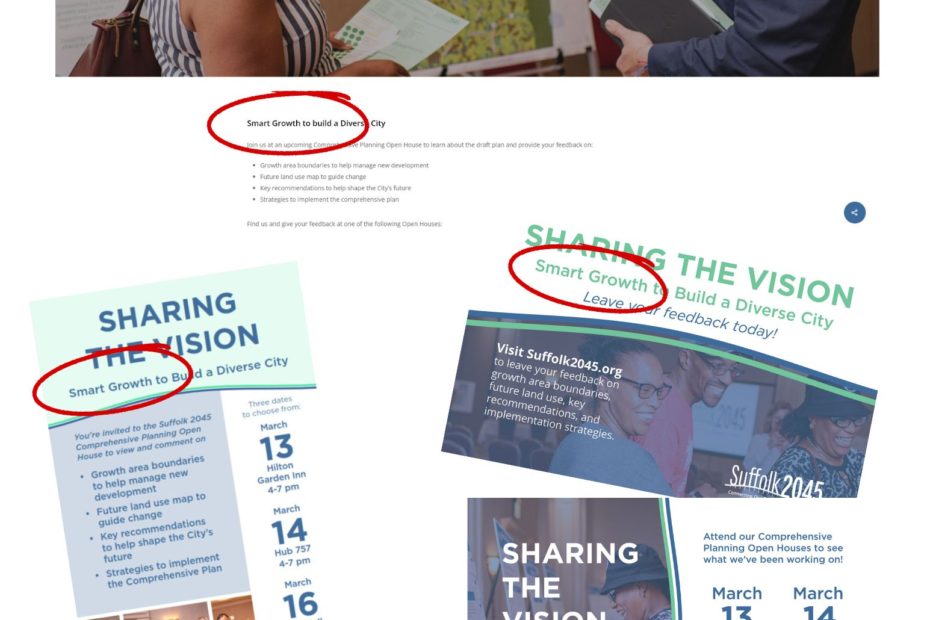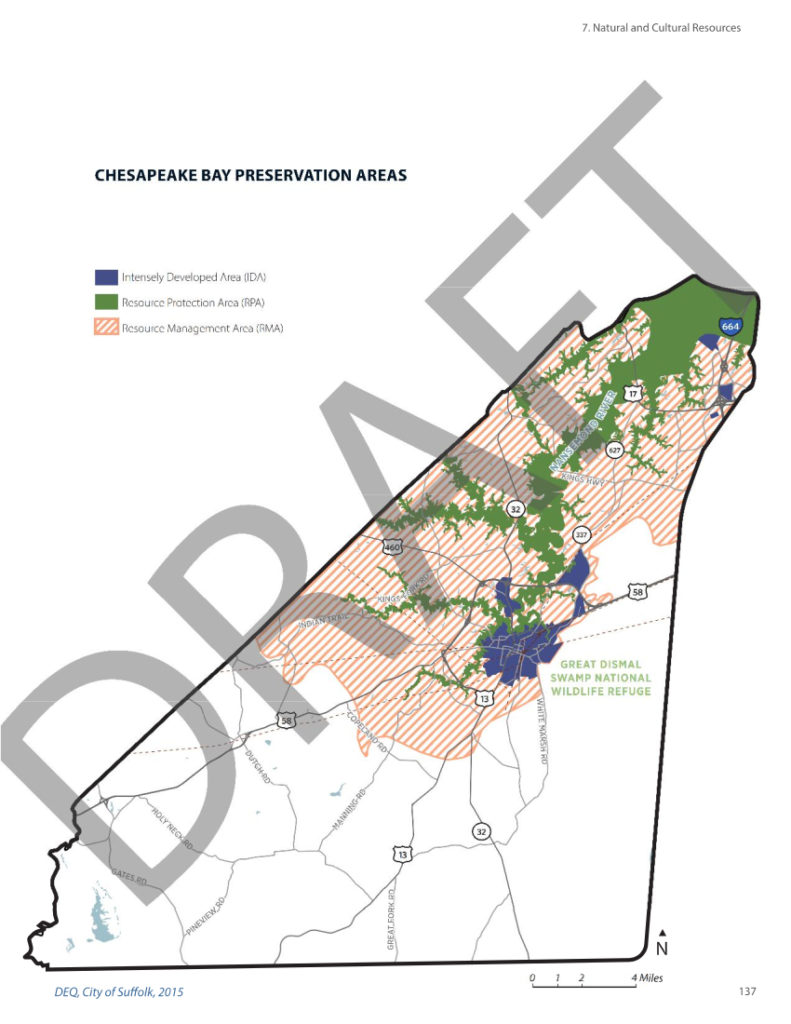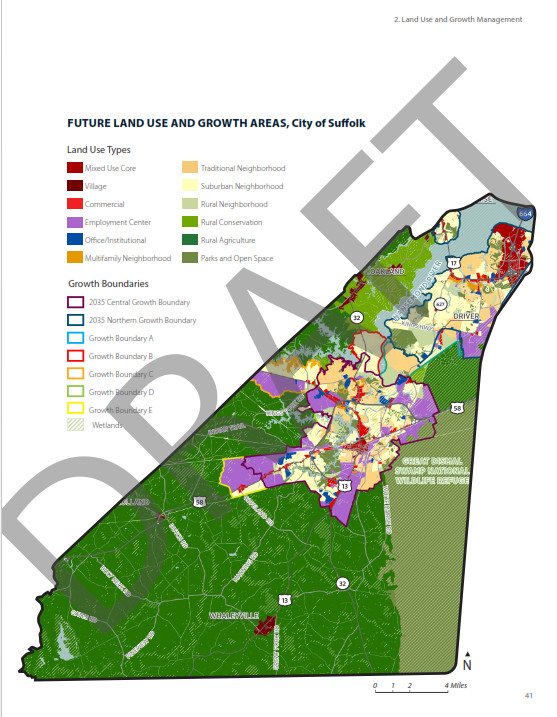The City of Suffolk has been working on the new Comprehensive Plan for two years and it is expected to be voted on this year. It will be implemented immediately if approved by City Council. During the two-year process, the public advertising for the new plan prominently mentioned Smart Growth. It was on the website, the handouts, and was incorporated into the tagline: Sharing the Vision – Smart Growth to Build a Diverse City.
When the new draft was publicized in February of this year, I was excited to check it out and raced to see how they incorporated Smart Growth into the new Comprehensive Plan draft. Spoiler alert: they didn’t. Despite the advertising, ‘Smart Growth’ doesn’t appear in the new draft even once.
Smart Growth is an Environmental Protection Agency (EPA) program started roughly 30 years ago. You can read more about it here and here. Essentially, it is a set of guiding principles for development and conservation intended to enhance people’s health and natural environment while making cities more diverse and economically strong. It strives to create communities where people want to live, work and spend time. It is an approach that cities and towns around the country are using to promote a better community for their citizens.
Below are the Principles of Smart Growth:
• Mix land uses
• Take advantage of compact building design
• Create a range of housing opportunities and choices
• Create walkable neighborhoods
• Foster distinctive, attractive communities with a strong sense of place
• Preserve open space, farmland, natural beauty, and critical environmental areas
• Strengthen and direct development towards existing communities
• Provide a variety of transportation choices
• Make development decisions predictable, fair, and cost effective
• Encourage community and stakeholder collaboration in development decisions
There are so many ways this new Comprehensive Plan is contrary to Smart Growth, but let’s begin with the huge expansion to the Growth Areas. City managers are looking to expand the Growth Area in Suffolk by nearly 25%, which is unprecedented in previous Comprehensive Plans. This will create more sprawl, which is detrimental to strong, inward growth – a key facet of Smart Growth.
This Smart Growth principle is simple: limiting growth to areas with existing infrastructure will save money long-term with less infrastructure upkeep. Additionally, focusing growth inward helps bring more businesses and housing options to the downtown area. Infill development is building on unused and underutilized land. It is aimed at areas with existing transportation and utility infrastructure. It repurposes or replaces existing buildings, parking lots, or other impervious areas to add homes and businesses near the center of cities.
When the City of Suffolk began expansion in the North Suffolk area, new growth and development ended up there instead of focusing in the downtown area. It is cheaper and easier for developers to build on farmland. It is flat, clear, and cheap, allowing them to maximize their profits. But the city manager’s job is not to maximize profits for developers. The city needs to partner with developers willing to invest in downtown. It isn’t as easy, but it will lead to a more vibrant and healthier Suffolk in the long run. Instead, city management is pushing for development to the west side of Suffolk. Will we end up with a West Suffolk as well as a North Suffolk? What does this mean for Downtown?
Other ways the new Comprehensive Plan doesn’t follow Smart Growth:
Create walkable neighborhoods: When you look at the new developments that have been springing up throughout Suffolk, walkable is not a descriptive word you would associate with most of them. Many do have sidewalks (more infrastructure for the city to maintain) but they don’t provide any place to go. Some do connect with a couple of commercial businesses, but by no means does it make the community walkable. A walkable community is when you can walk to schools, work, churches, shopping, parks, restaurants, etc. and there are very few new developments in Suffolk that meet this principle.
Foster distinctive, attractive communities with a strong sense of place. Walkable communities tend to have this by the very nature of the mixed use areas in close proximity. Communities are not just houses in one area, they are a variety of homes, surrounded by the activities (mentioned in the walkable neighborhood) that the people use every day.
Preserve open space, farmland, natural beauty, and critical environmental areas. Suburban and industrial sprawl destroy natural open spaces, farmland and critical environmental areas. Below you can see the Chesapeake Bay Preservation Area (CBPA). The City of Suffolk already has its current Growth Area entirely within the CBPA and this new Comprehensive Plan will extend the Growth Area to cover even more of it. Development in this area pollutes our waterways, which impacts the sea life (an important source of food) in the Chesapeake Bay as well as the surrounding rivers. It also negatively impacts the reservoirs in Suffolk that provide drinking water to the citizens of Suffolk, Norfolk, and Portsmouth. The plan’s Appendices list 37 waterways in Suffolk that have impaired water quality. Previous versions of the Comprehensive Plan acknowledge the importance of minimizing development near these critical waterways, but the new draft has done an about-face and is encouraging development on these natural resources instead.
Encourage community and stakeholder collaboration in development decisions.
City planners say that this plan represents a combination of what the community and the “stakeholders” (i.e. developers) want for the future of Suffolk. They say everyone isn’t going to get everything they want! However, this new plan is contrary to the public feedback the city received while working on this new draft. If this isn’t what the public wants, then that means the city managers are listening more to the stakeholders than they are to the public. Developers are getting what they want at the expense of the citizens.
This new plan will exacerbate suburban sprawl and encourage huge swaths of land to be rezoned for warehouses. This sprawl will negatively impact Downtown Suffolk by creating vast new growth to the West of downtown. This expanded Growth Area and these new developments do not align with Smart Growth. So why did city managers include Smart Growth in all the publications? Did they start down the Smart Growth path, but then make a 180° when it didn’t match with what developers wanted?
It seems that our city management doesn’t respect what the citizens want. If we do nothing, then nothing changes. However, if you don’t like this new plan – if you don’t want to see more warehouses and the continued sprawl in Suffolk – you need to act. We all need to act. This process will soon move through the Planning Commission and on to City Council by this summer. City Council will then vote to approve or not approve the new comprehensive plan. If you don’t want this for the future of Suffolk, let City Council and the Mayor know where you stand.
Let City Council know what you think about this new growth area: council@suffolkva.us
Michael D. Duman, Mayor
mayor@suffolkva.us
Phone: 757-514-4009
Lue R. Ward, Jr., Vice Mayor
(Nansemond Borough)
nansemond@suffolkva.us
Phone: 757-377-6929
Shelley Butler Barlow,
Council Member
(Chuckatuck Borough)
chuckatuck@suffolkva.us
Phone: 757-346-8355
Leroy Bennett, Council Member
(Cypress Borough)
cypress@suffolkva.us
Phone: 757-407-3750
Timothy J. Johnson, Council Member
(Holy Neck Borough)
holyneck@suffolkva.us
Phone: 757-407-0556
Roger W. Fawcett, Council Member
(Sleepy Hole Borough)
sleepyhole@suffolkva.us
Phone: 757-377-8641
John Rector, Council Member
(Suffolk Borough)
suffolk@suffolkva.us
Phone: 757-407-1953
LeOtis Williams, Council Member
(Whaleyville Borough)
whaleyville@suffolkva.us
Phone: 757-402-7100


